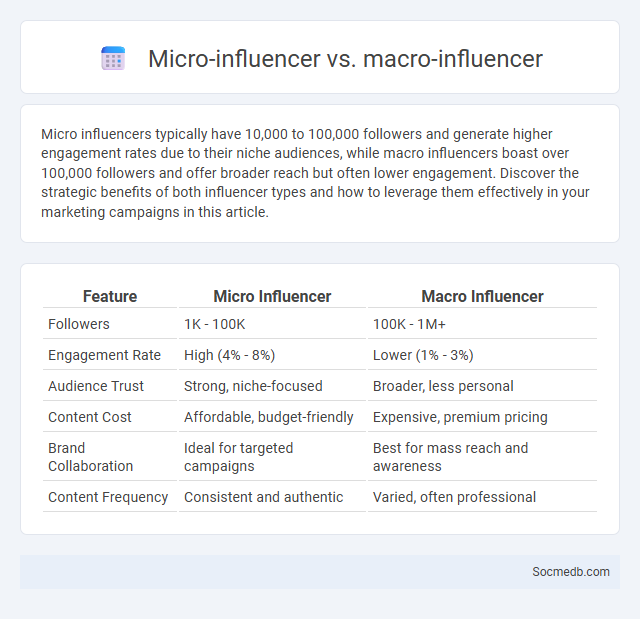
Photo illustration: Micro influencer vs macro influencer
Micro influencers typically have 10,000 to 100,000 followers and generate higher engagement rates due to their niche audiences, while macro influencers boast over 100,000 followers and offer broader reach but often lower engagement. Discover the strategic benefits of both influencer types and how to leverage them effectively in your marketing campaigns in this article.
Table of Comparison
| Feature | Micro Influencer | Macro Influencer |
|---|---|---|
| Followers | 1K - 100K | 100K - 1M+ |
| Engagement Rate | High (4% - 8%) | Lower (1% - 3%) |
| Audience Trust | Strong, niche-focused | Broader, less personal |
| Content Cost | Affordable, budget-friendly | Expensive, premium pricing |
| Brand Collaboration | Ideal for targeted campaigns | Best for mass reach and awareness |
| Content Frequency | Consistent and authentic | Varied, often professional |
Understanding Micro Influencers: Definition and Key Traits
Micro influencers are social media users with a follower count typically between 10,000 and 100,000, known for their niche expertise and highly engaged audiences. Their key traits include authenticity, strong community relationships, and high levels of trust and interaction, often resulting in improved conversion rates for brands. Unlike macro influencers, micro influencers offer more targeted reach and personalized content, making them valuable for precise marketing strategies.
Macro Influencers: Reach, Impact, and Characteristics
Macro influencers typically boast follower counts ranging from 100,000 to 1 million, granting them substantial reach across diverse audiences. Their content generates high engagement rates and significant brand impact, making them ideal for campaigns targeting mass awareness and trust. Your brand can leverage macro influencers' authentic voice and established credibility to amplify messaging effectively.
The Rise of Brand Partnerships in Digital Marketing
The rise of brand partnerships in digital marketing has transformed social media into a dynamic platform for authentic collaborations that amplify reach and engagement. By leveraging influencers and complementary brands, companies create targeted campaigns that resonate deeply with specific audiences, enhancing brand credibility and driving conversions. Your social media strategy should prioritize these partnerships to maximize visibility and foster meaningful connections in an increasingly competitive digital landscape.
Micro Influencer vs Macro Influencer: Engagement Rates Comparison
Micro influencers typically achieve higher engagement rates compared to macro influencers due to their niche audiences and personalized content. Studies show micro influencers often generate engagement rates between 3-8%, while macro influencers usually see rates closer to 1-3%. Brands leverage micro influencers for authentic connections and greater user interaction despite their smaller follower counts.
Cost Analysis: Investing in Micro vs Macro Influencers
Cost analysis of social media marketing reveals that investing in micro influencers often yields higher engagement rates at lower costs compared to macro influencers, who command premium fees for broader reach. Brands targeting niche audiences benefit from micro influencers' authentic connections, resulting in improved conversion rates and cost efficiency. Evaluating return on investment (ROI) requires balancing the extensive audience exposure from macro influencers against the targeted, budget-friendly impact of multiple micro influencer collaborations.
Audience Targeting: Which Influencer Type Delivers Better ROI?
Micro-influencers consistently deliver better ROI due to their highly engaged niche audiences and authentic connections, which drive higher conversion rates compared to macro-influencers. Brands targeting specific demographics often achieve more precise audience targeting and cost-effective campaigns through micro-influencers, especially on platforms like Instagram and TikTok. Data shows engagement rates for micro-influencers average between 3% to 5%, significantly outperforming the 1% to 2% rates of larger influencers.
Authenticity and Trust: Micro vs Macro Influencer Perception
Micro influencers generate higher engagement rates and foster stronger trust among niche audiences due to their perceived authenticity and closer relationships. In contrast, macro influencers often reach broader demographics but may face skepticism regarding endorsements, impacting trust levels. Brands balancing authenticity and reach strategically leverage micro influencers to enhance credibility and connect deeply with target communities.
Brand Partnerships: Benefits, Challenges, and Best Practices
Brand partnerships on social media amplify reach by leveraging combined audiences and fostering authentic engagement through collaborative content creation. Challenges include aligning brand values, managing consistent messaging, and measuring ROI effectively across diverse platforms. Best practices emphasize clear communication, defined goals, and utilizing analytics tools to optimize campaign performance and strengthen consumer trust.
Choosing the Right Influencer for Your Brand Collaboration
Selecting the right influencer for your brand collaboration requires analyzing audience demographics, engagement rates, and content alignment with your brand values. You should prioritize influencers whose followers match your target market to maximize reach and conversion potential. Authenticity and credibility in their niche will boost your campaign's effectiveness and foster genuine consumer trust.
Case Studies: Successful Micro, Macro, and Brand Partnership Campaigns
Case studies reveal that micro-influencers generate authentic engagement with niche audiences, boosting brand awareness by 60% in targeted demographics. Macro-influencers amplify reach exponentially, delivering up to 2 million impressions per campaign while maintaining high conversion rates. Brand partnership campaigns combining diverse influencer tiers achieve optimal ROI, with collaborative strategies increasing social media-driven sales by 35%.
 socmedb.com
socmedb.com